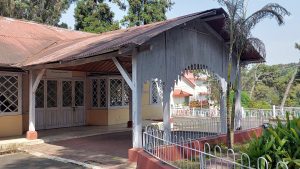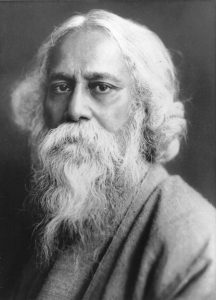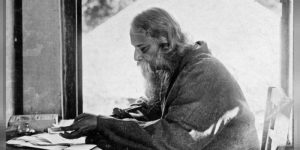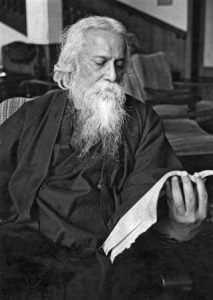By Uma Purkayastha
 Rabindranath Tagore, the first great poet Laureate of Asia visited Shillong thrice during 1919, 1923 and 1927 respectively, and left an indelible mark in the history of Shillong.
Rabindranath Tagore, the first great poet Laureate of Asia visited Shillong thrice during 1919, 1923 and 1927 respectively, and left an indelible mark in the history of Shillong.
During his second visit, on June 9, 1923, while staying at ‘Jitbhumi’ Rilbong, he had composed a very interesting poem ‘Shillong-er-Chithi’ (Letter from Shillong), describing natural beauty of Shillong; a humorous letter in verse, where we find his enthralling and attracting expressions of Shillong during summer time, as:-
“When the scorching heat of burning summer,
Couldn’t be ebbed by cold beverages and air from fans,
Exhausted, I rushed to the Shillong hills,
To be cooled with pleasant chill”!
[Translated by the Author]
 The whole poem is filled with descriptions of the glamorous beauty of Shillong which the poet penned in verse; and last of all commented, ‘After all, Shillong is a very good place’!
The whole poem is filled with descriptions of the glamorous beauty of Shillong which the poet penned in verse; and last of all commented, ‘After all, Shillong is a very good place’!
This poem, till day, inspires and enthuses tourists from home and abroad to visit Shillong especially during summer time.
During April 1927, the weather was exceedingly hot in Shantiniketan. The poet’s heart was yearning for Shillong, the very peaceful and soothing hill destination. But financially, he was not in a position to revisit the hill station. Soon enough, to his utter surprise, he received an invitation from one of his dear friends, Ambalal Sarabhai, a renowned industrialist of Ahmedabad, to visit Shillong and spend the summer holidays there, under his hospitality at Upland Road, Shillong.
The poet was thrilled and accepted the invitation and thereafter began his journey to Shillong on May 6,1927. He was lodged at ‘Solomon Villa’ Upland Road, Shillong.
 Tagore had composed many poems and novels while staying at Upland Road, and mentioned in one of his letters that the serene natural beauty and uninterrupted solitude of his former stays at ‘Brookside’ and ‘Jitbhumi’ was absent there. He remarked “It was a different Shillong ”.
Tagore had composed many poems and novels while staying at Upland Road, and mentioned in one of his letters that the serene natural beauty and uninterrupted solitude of his former stays at ‘Brookside’ and ‘Jitbhumi’ was absent there. He remarked “It was a different Shillong ”.
In one of his letters to Ranu on May 28, 1927, from ‘Solomon Villa’, Tagore wrote very humorously:
…… “There is always the presence of curious visitors to gaze at me, just like people go to visit lions in the Circus Party. Though the lion feels offended, the visitors feel entertained, and I am thinking of introducing a ticket system at the rate of Rs. 5/- per head for the show ….”
 This letter indicates that the common people could visit Tagore freely, whereas during other visits in the past he was somehow isolated from the public though Rabindra’s biographer Prabhat Kr. Mukhopadhaya commented that even during the third visit of Tagore, there was no public reception for the poet from any corner of Shillong.
This letter indicates that the common people could visit Tagore freely, whereas during other visits in the past he was somehow isolated from the public though Rabindra’s biographer Prabhat Kr. Mukhopadhaya commented that even during the third visit of Tagore, there was no public reception for the poet from any corner of Shillong.
During his stay, Tagore received an invitation to attend a Khasi Dance festival during his last stay in Shillong, which he accepted very heartily and attended duly. He sincerely appreciated the Drum beating and the skills through the Bow and Arrow dance. It was quite a new experience for the poet. Even though not mentioned in texts, it was most likely the festival of ‘Shad Suk Mynsiem’ which is generally celebrated in the month of May-June by the Seng Khasi.
Tagore enjoyed the festival cheerfully, and sincerely appreciated their performances which was something new to him. He was not acquainted at all with the culture and tradition of the indigenous people of Khasi and Jaintia Hills.
 It is believed that the organisers of the festival presented Tagore with a pair of bow and arrow as a token of their love and respect for him, which was graciously accepted by the poet.
It is believed that the organisers of the festival presented Tagore with a pair of bow and arrow as a token of their love and respect for him, which was graciously accepted by the poet.
It is also believed that one of the organisers of that Dance festival was U Soso Tham, the National poet of Meghalaya today, who could meet Tagore and was highly inspired by his words.
[Ref:- ‘Tagore And Pineland Shillong’ Pg. 202. by Uma Purkayastha]
Tagore, during that sojourn, was also invited by the Assam Bengal Theatre Party of Shillong to attend a Drama performance in the Quinton Hall premises; but due to some urgency, he had to leave Shillong before the performance.
The poet left Shillong on June 10, 1927, and that was his last sojourn in Shillong. He had a keen desire to visit Shillong again, but it did not materialise.
Though Tagore visited Shillong thrice, he could not be acquainted with the people in general nor the indigenous population of Shillong because of some political restrictions at the time. He was under Royal-Wrath due to his violent protest against the Jallianwala Bagh Massacre 1919; but despite all hurdles, the poet could make place in the hearts of the common public of Shillong, and specifically the indigenous people, who could not even understand his language but cherished a big respect and love for the great poet.
The great works of the bard and his influence percolated through im Shillong too. A clear example is that of Helimon Khongphai, the first Khasi female graduate from the United Khasi and Jaintia Hills, who is also a pioneer of translating Tagore’s poems into Khasi language to enable the Khasi people to learn about Rabindranath Tagore. She was well versed in Bengali as she studied in Dacca (now Dhaka) with the help of the Brahmmo Samaj and graduated from the Calcutta University (University of Calcutta) with the help of Ramakrishna Mission; and she had even the great opportunity to meet Rabindranath Tagore during her stay at Calcutta. [Interview with the author 25th June 1979]
In 1940, she was appointed as Asstt. Teacher in the Govt. Girls’ High School Shillong, and with the help of her students she could stage in the school auditorium many dramas of Tagore, translating into Khasi, eg. ‘Lakshmir Pariksha’, ‘Samanya Kshati’, ‘Devotar Grash’. Unfortunately her accomplishments were not preserved nor published.
Khongphai had a thorough study on Tagore’s Literature and even claimed,
“Gurudev’s ‘Naivedya’ (A book on poems) is like the Bible to me. Every line of ‘Naivedya’ is full of inner devotion towards that creator who has no caste or creed and does not belong to anyone, country or time”.
During the Birth Centenary Celebration of Rabindranath Tagore in the year 1961, Khongphai delivered an invaluable speech on Tagore in Bengali at a public gathering, in the ‘Sidhli House’ premises on September 3, 1961. It is known that the speech was later published in the ‘Ananda Bazar Patrika’, Calcutta. [Ref:- Mrs. Kalpana Gupta. Reporter ‘Ananda Bazar Patrika’ Shillong]
Later in 1966, Tagore’s Gitanjali was first translated into Garo language by Harendra W Marak, as well as Wilson Marak from Tura, who translated Tagore’s compositions into Garo and published a book in the name, ‘RABINDRANATH TAGORE NI BASEGIMIN GOLPORANG AROPOIDORANG’ (1973) which were well received by the people of Garo Hills.
Later, Esther Nora Lyngdoh also translated a good number of Tagore’s short stories and a few poems in Khasi and published a book by the name ‘Ki KHANA BAD JINGRWAI MYLLUNG JONG U RABINDRANATH TAGORE’ (1973)
In 1984, E. Weston Dkhar translated ‘Gitanjali’ in Khasi, titled ‘Tanga Ka Jingainguh Thang.’ Other translations of Gitanjali include those of Dr. Pascal Malngiang in 1988, as ‘Ka Gitanjali U Tagore’, and that of eminent Khasi writer S. Norindel Roy’s Khasi version of ‘Gitanjali’ in 1992.
Apart from his literary works, Prof. Chesterfield Khongwir of Shillong, a renowned singer translated two very famous songs of Tagore, (i) ‘Klanti Amar Kshoma Karo Prabhu’ (This Weariness of Mine, Forgive O My Lord) into Khasi as, ‘Kane Ka Jingthait To Map ia Nga A Blei’…..
This translated song of Tagore was sung by Prof. Khongwir himself participated in a cultural programme organised by the ‘Banga Sanskriti Sammelan’ in Kolkata, and was highly appreciated by the audience.
In this way, Tagore’s grand legacy in Shillong and in the state of Meghalaya has been kept alive. However, it does not stop here. Some budding talents from the Khasi community have been inclined towards earning mastery in the original Rabindra Sangeet (in Bengali) and one of them is Dr. Smti. Lapyshai Syiem, Prof. of North Eastern Hill University. Syiem is a popular ‘Rabindra Sangeet’ singer who also released her audio titled ‘Amar a Poth’ based on Tagore’s song sung in Bengali. It is a great melodious tribute to Tagore from the Khasi society of Shillong.
Among others from academia, Prof. Streamlet Dkhar, Head of the Department of Khasi, North Eastern Hill University, in her article, ‘U Rabindranath Tagore’ mentioned:- ‘U Khlue Ba Lai Sah Nam Ka Ri India’, describing the versatility of the great poet and his contributions towards the literary and philosophical fields of India. She denominated Tagore as the brightest star in the sky of ‘Mother India’. She states ‘Tagore has had an impact on Khasi Literature’.
(L) Andreas Sun, Former Joint Project Director of Meghalaya had also composed a poem in English, ‘A Tribute to Rabindranath Tagore’, the last two lines of which are:-
…’Thou art not only of the Bengalees,
Also thou art for all, And of the Khasis’.
It is a very candid expression of the admiration and awe of the poet towards Tagore.
Nowadays, many talented students of Meghalaya take admission in Tagore’s Shantiniketan to study his creations more widely.
It is worth mentioning that the Department of Arts & Culture Govt. of Meghalaya has also shown interest in this regard to retain and elevate Rabindra Culture in the state, through celebrations of Rabindra Birth Anniversary with multilingual programmes and establishing Tagore Memorial Cultural Complex. In fact, Indian Cultural Centre of Research (I.C.C.R) Shillong has also sincerely extended its hearty co-operation in each and every affair pertaining to Tagore and cultural programmes around it.
It is indeed interesting and thrilling to note that even after 73 years of his demise, Tagore’s spirit through his everlasting creations are alive in Meghalaya through such efforts.
Tagore’s expression of universal love and concord:-
‘Thou hast made known to me friends
whom I knew not, Thou hast given me
seats in the homes, not my own
Thou hast brought the distant near to me
And made the strangers my brothers’…..
Images of Tagore – Wikicommons



